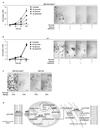Breast cancer cells rely on environmental pyruvate to shape the metastatic niche
- PMID: 30814728
- PMCID: PMC6451642
- DOI: 10.1038/s41586-019-0977-x
Breast cancer cells rely on environmental pyruvate to shape the metastatic niche
Abstract
The extracellular matrix is a major component of the local environment-that is, the niche-that determines cell behaviour1. During metastatic growth, cancer cells shape the extracellular matrix of the metastatic niche by hydroxylating collagen to promote their own metastatic growth2,3. However, only particular nutrients might support the ability of cancer cells to hydroxylate collagen, because nutrients dictate which enzymatic reactions are active in cancer cells4,5. Here we show that breast cancer cells rely on the nutrient pyruvate to drive collagen-based remodelling of the extracellular matrix in the lung metastatic niche. Specifically, we discovered that pyruvate uptake induces the production of α-ketoglutarate. This metabolite in turn activates collagen hydroxylation by increasing the activity of the enzyme collagen prolyl-4-hydroxylase (P4HA). Inhibition of pyruvate metabolism was sufficient to impair collagen hydroxylation and consequently the growth of breast-cancer-derived lung metastases in different mouse models. In summary, we provide a mechanistic understanding of the link between collagen remodelling and the nutrient environment in the metastatic niche.
Conflict of interest statement
The authors declare to have no financial or non-financial competing interest. SMF has received research funding from Bayer AG and Merck.
Figures














Comment in
-
Renovation in progress.Nat Rev Cancer. 2019 May;19(5):246. doi: 10.1038/s41568-019-0131-y. Nat Rev Cancer. 2019. PMID: 30890773 No abstract available.
References
-
- Elia I, Fendt S-M. In vivo cancer metabolism is defined by the nutrient microenvironment. Translational Cancer Research. 2016;5:S1284–S1287.
-
- Elia I, Doglioni G, Fendt S-M. Metabolic Hallmarks of Metastasis Formation. Trends in Cell Biology. 2018 - PubMed
MeSH terms
Substances
LinkOut - more resources
Full Text Sources
Other Literature Sources
Medical

